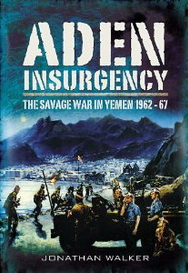LINKS
& RECOMMENDED READING
Aden Insurgency: The Savage War in Yemen 1962-67
by Jonathan Walker, first published 2005 by Spellmount;
Reprinted 2011 by Pen & Sword.
 |
This is a first class and comprehensive account of one of those half-wars at the close of Empire. Malaya and Cyprus were both ‘emergencies’, the Mau Mau had an uprising, Borneo and Indonesia a confrontation. Aden (or South Arabia) was dubbed an insurgency.
This book has been written by a military historian and he is as good on the historical background and the politics as he is on the military campaigns.
The scope is large. It begins with the Kingdom of Sheba and its legendary Queen. It deals with attempts at the federation of some of the disparate Sheikdoms. It gives a very good account of the Radfan Campaign of 1964 and it then homes in on the last years and months. |
Although reprinted in 2011 there has been little obvious attempt at revision (save mention of the death of Osama bin Laden - himself a Yemeni) and perhaps one regret is that the author did not take advantage of the publication (also 2011) of The War That Never Was (Duff Hart-Davis, Century) which shines a new light on the civil war in Yemen during much the same period. But that is a small cavil: this is an excellent book and will give great pleasure to those who have felt that such a book is long overdue. It will fascinate and probably inform most who served there.
It is meticulously researched and the footnotes are copious. Perhaps it would have been easier on the reader if these had been at the foot of each page and not grouped at the end of each chapter, but that is a small niggle as they are numerous, comprehensive and informative.
Perhaps one of this book’s greatest strengths is the question of context. We are in the middle of the Cold War. Russia is meddling in the Middle East. Egypt is meddling in Yemen (and elsewhere). The civil war is tearing Yemen apart. And at the very tip of the Arabian Peninsula a vital strategic colony is teetering between obsolescence as a major port and federation with hill tribes with whom it shares little. Here we find a large expatriate community perched on the edge of two rocky outcrops. Into this are poured large numbers of British servicemen most of whom have been training to face the Soviets on the north German plain.
Inevitably the book dwells at length on the closing few months of the campaign in 1967 and the street fighting then in the districts of Crater and Sheik Othman. One could argue that perhaps not quite the same understanding is shown of the work of those units which flogged on through the heat and stench of month after month protecting British interests and British civilians. They too were stuck there as the cack-handed plans for withdrawal were pieced together by a Labour government which couldn’t wait to quit from the rest of the Empire and from east of Suez in particular. Having announced withdrawal, ‘but not just yet’, all Europeans were a target for the various terrorist organisations. All that united the terrorists / freedom fighters after all was a wish to be seen to be driving out the British. Their targeting of the British, mainly with hand grenades, was indiscriminate and often lethal. Its effect on nerves and morale was significant.
If one could have a complaint it is perhaps that the author has been swayed by the cult of the Argylls and their heroics in re-entering Crater after the rebellion by the Aden Armed Police. There is no doubt that there were excellent battle drills and heroism in good measure but it was for dubious motives and the self-seeking, self-advertising and unbounded ego of their CO, Lieutenant Colonel Colin Mitchell. In the author’s words: ‘The fact that Mitchell had organised press coverage of the re-entry can hardly have endeared him to MEC (Middle East Command).’ Whatever the rights and wrongs of that the dénouement was that he was carpeted by no less a person than the C-in-C himself, Admiral Sir Michael Le Fanu, for what is called ‘a disloyal Part I (ie written) Order’. His long-term military career was over: his future lay, for a short while, in politics. Such has been the enduring success of this tale that it was not until reading this book that this writer was aware that the first part, the important part, of their re-entry to Crater was at dusk and the whole operation complete in 24 hours with only one casualty (a local national) and few shots being fired.
How can one describe Yemen as a failed or failing state? This book demonstrates why it never did succeed. It is no more than a geographical region. So rugged is the countryside - although majestic and beautiful too - and so sparse and various the tribes that no form of centralised government has ever stood much of chance. Add to that the ingrained tradition of blood feuds and a preference for violence over reasoned argument and it’s hard to see how the traditional rulers can ever be coerced into any recognisable form of democracy. Given the almost complete lack of natural resources and a preference for growing quat (a mind-numbing but fairly harmless narcotic) over coffee and it’s easy to see why centralised government has all but failed so far. Their one hope for earning convertible currency would be tourism but that is probably the last thing that any outsider should contemplate. That is a great pity. This writer, for one, would love to revisit the colony and the magical mountains; to see again the wonderful scenery, the ancient relics and the towering villages. And then in the afternoon to relax on a sandy beach, inside a shark net of course, and soak up the almost endless sun which would make a return to Aden complete.
It says much for this excellent book that such thoughts after all these years have overtaken the memories of the stench of drains and goats and the sometimes almost unbearable heat, not to mention the ever-present danger which seemed to lurk around every corner.
One footnote for those of The Cameronians (Scottish Rifles) who served in South Arabia with the 1st Battalion - May 1966 to February 1967. The index is very adequate but only after you have tracked down the entry. Because of the date of publication the author / publishers have relied on a modern Army List where the regiment appears only as a footnote. It should, of course, be listed after the King’s Own Scottish Borders (25th) but it appears over the page after all of the rest of the infantry. At least it is there.
PRG
Hardback 332 pages
ISBN: 9781848845480
Published: 19 September 2011
~~~~~~~~~~~~~~~~~~~~~~~~~~~~~~~~~~~~~~~~~
|

